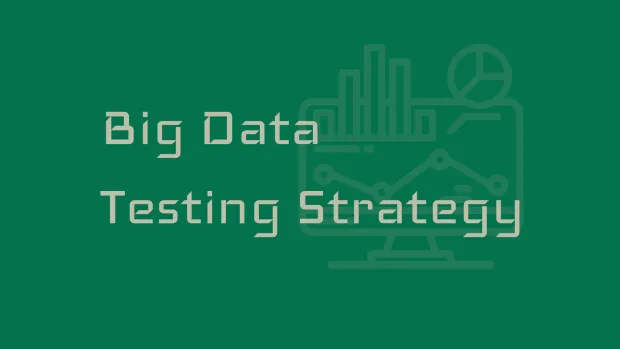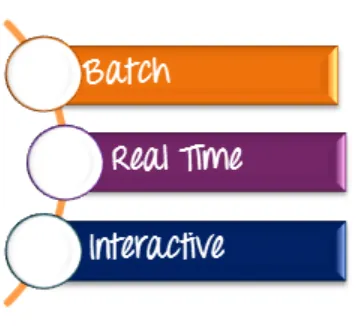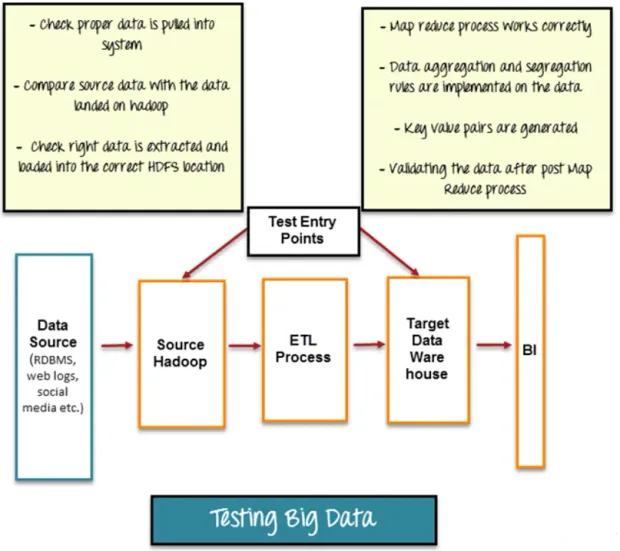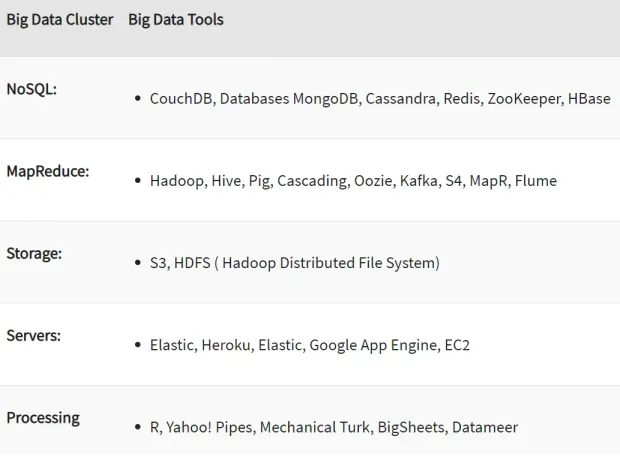Big Data - Testing Strategy
With the exponential growth in the number of big data applications in the world, Testing in big data applications is related to database, infrastructure and performance testing and functional testing. This blog guides what should be the strategy for testing Big Data applications.

Table of Contents
- Big Data - Introduction
- Big Data Testing
- Big Data Testing - Test Data
- Big Data Testing - Test Environment
- Big Data - Performance Testing
- Tools used in Big Data Scenarios
- Big Data Testing - Challenges
- Conclusion
Big Data - Introduction
Big Data - Introduction
Earlier, we were only dealing with well-structured data, hosted in large data warehouses, and investing a cost in maintaining those data warehouses and hiring expert professional to maintain and secure information hosted in that data warehouse. Data was structured and can be queried anything as per the needs. But now, this exponential growth of data generates a new vision for data science along with some major challenges.
Big Data is something which is growing exponentially with time, and carry raw but very valuable information inside that can change the future of any enterprise. It is a collection, which represents a large dataset, may be collected from multiple sources, or stored in an organization. Let‟s understand a real-time example, Big companies like Ikea and Amazon are leveraging the benefit of big data by collecting data from customer‟s buying patterns at their stores, their internal stock information, and their inventory demand-supply relations and analyze all, in seconds even in real-time to add value to its customer experience.
So, extracting information from a large dataset somewhat calls a concept of Data mining which is an analytic process originally designed to explore large datasets. The ultimate goal of data mining is to search for consistency in a pattern or systematic relationship between variables, which helps in predicting the next pattern or behavior.
Now, if we take concepts of data mining forward along with large data set, to some extent it becomes a blocker for our existing approach, because big data may contain structured or unstructured data even it may contain data in multiple formats also.
Big Data Testing
Testing is an art of achieving quality in your software product, in terms of perfection of functionality, performance, user experience, or usability. But for big data testing, you need to keep your focus more on the functional and performance aspects of an application. Performance is the key parameter in any big data application which is meant to process terabytes of data. Successful processing of terabytes of data using a commodity cluster with a number of other supportive components needs to be verified. Processing should be faster and accurate which demands a high level of testing.
Processing may be of three types:–

And based on which, we need to integrate different components along with NoSQL data store as per the needs.
Big Data Testing - Test Data
Data plays a vital role in the testing of big data applications. Application is meant to process data and provide an expected output based on implemented logic. The logic needs to be verified before moving to production, as the implementation of logic is completely based on business requirements and data.
1. Test Data Quality
Good quality test data is as important as the test environment. In the big data world, data can have any format or size, it may be in the form of a document, XML, JSON, PDF, etc. at the same time data size may go up to terabytes of petabytes. Hence, test data should also have multiple formats and size should be large enough to ensure the handling of large data processing. In big data testing, it needs data with logical values as per the application requirement and format which is supported by the application.
Along with it, data quality is another aspect of big data testing. Ensuring the quality of data before processing through application ensures the accuracy of the final output. Data quality testing itself is a huge domain and covers a lot of best practices which include – data completeness, conformity, accuracy, validity, duplication, and consistency, etc. It should be included in the big data testing and this ensures the level of accuracy application is supposed to provide.
2. Test Data Generation
The generation of test data is again a challenging job, there are multiple parameters, which have to be taken care of while generating test data. It needs a tool, which can help to generate data and should have functions or logic can also be applied over it. Tools like Talend (an open studio) is the best candidate to fulfill the requirements of data generation.
3. Data Storage
After the generation of test data along with quality, it needs to host on a file system. For testing big data applications, data should be stored in the system similar to the production environment. As we are working in big data space, there should have a different number of nodes, and data must be in a distributed environment.
Big Data Testing - Test Environment
In Big data testing, the test environment should be efficient enough to process a large amount of data as done in the case of a production environment. Real-time production environment clusters generally have 30-40 nodes of cluster and data is distributed on the cluster nodes. There must have some minimum configuration for each node used in the cluster. A cluster may have two modes, in-premise or cloud. For testing in big data, it needs the same kind of environment with some minimum configuration of node.
Scalability is also desired to be there in the test environment of big data testing, it helps to study the performance of application with the increase in the number of resources. That data can be used to define SLA (service level agreement) for that particular application.
Big Data Testing can be categorized into three stages:

Step 1: Data Staging Validation
The first stage of big data testing, also known as a Pre-Hadoop stage, is comprised of process validation.
- Validation of data is very important so that the data collected from various source like RDBMS, weblogs, etc are verified and then added to the system.
- To ensure data match you should compare source data with the data added to the Hadoop system.
- Make sure that the right data is taken out and loaded into the accurate HDFS location
Step 2: “Map Reduce” Validation
Validation of “Map Reduce” is the second stage. Business logic validation on every node is performed by the tester. Post that authentication is done by running them against multiple nodes, to make sure that the:
- The process of Map Reduce works perfectly.
- On the data, the data aggregation or segregation rules are imposed.
- Creation of key-value pairs is there.
- After the Map-Reduce process, Data validation is done.
Step 3: Output Validation Phase
The output validation process is the final or third stage involved in big data testing. The output data files are created and they are ready to be moved to an EDW (Enterprise Data Warehouse) or any other such system as per requirements. The third stage consisted of:
- Checking on the transformation rules is accurately applied.
- In the target system, it needs to ensure that data is loaded successfully and the integrity of data is maintained.
- By comparing the target data with the HDFS file system data, it is checked that there is no data corruption.
Big Data - Performance Testing
Big data applications are meant to process a large amount of data, and it is expected that it should take minimum time to process maximum data. Along with it, application jobs should consume a considerable amount of memory and CPU. In big data testing, performance parameter plays an important role and helps to define SLA's. It covers the performance of the base machine and cluster. Also, for example, In the case of Hadoop, map-reduce jobs should be written with proper coding guidelines, to perform better in the production environment. Profiling can also be done on map-reduce jobs before integration, to ensure their optimized execution.
Tools used in Big Data Scenarios

Big Data Testing - Challenges
In big data testing, certain challenges are involved which needs to be addressed by the big data testing approach.
1. Test Data
Exponential growth had been observed in the growth of data in the last few years. A huge amount of data are being generated daily and stored in large data centers or data marts. So, there is a demand for efficient storage and a way to process it in an optimized way. If we consider the telecom industry, it generates a large number of call logs daily and they need to be processed for better customer experience and compete in the market. The same goes with the test data, test data should be similar to production data and should contain all the logically acceptable fields in it.
This becomes a challenge for testing big data application, generating test data similar to production data is a real challenge. Test data should also be large enough to verify proper working big data application.
2. Environment
The processing of data highly depends on the environment and its performance. An optimized environment setup gives high performance and fast data processing results. Distributed computing is used for the processing of big data which has data hosted in a distributed environment. The testing environment should have multiple numbers of nodes and data should be distributed over the nodes. At the same time, it also needs to monitor those nodes, to ensure the highest performance with minimum CPU and memory utilization. Nodes should be monitored and there should have a graphical presentation of node performance. So, the test environment has two aspects – distributed nodes and their monitoring, which should be covered in the testing approach.
3. Performance
Performance is the key requirement of any big data application, and of course because of which enterprises are moving towards NoSQL technologies, technologies that can handle their big data and process in the minimum time frame. A large dataset should be processed in a minimum considerable time frame. In big data testing, performance testing is a challenge, it requires monitoring of cluster nodes during execution and also time is taken for every iteration of execution.
Conclusion
Big Data is the trend that is revolutionizing society and its organizations due to the capabilities it provides to take advantage of a wide variety of data, in large volumes and with speed. Keeping the challenges in mind we have defined the approach of testing big data applications. This approach of big data testing will make it easy for a test engineer to verify and certify the business requirement implementations and for stack holders, it saves a huge amount of cost, which has to be invested to get the expected business returns.

Featured Posts
TOTP Authentication Explained: How It Works, Why It’s Secure
Advantages of Time-Based One-Time Passwords (TOTP)
JWT Authentication with LoginRadius: Quick Integration Guide
Complete Guide to JSON Web Token (JWT) and How It Works
A comprehensive guide to OAuth 2.0
How Chrome’s Third-Party Cookie Restrictions Affect User Authentication?
How to Implement OpenID Connect (OIDC) SSO with LoginRadius?
Testing Brute-force Lockout with LoginRadius
Breaking Down the Decision: Why We Chose AWS ElastiCache Over Redis Cloud
LoginRadius Launches a CLI for Enterprise Dashboard
How to Implement JWT Authentication for CRUD APIs in Deno
Multi-Factor Authentication (MFA) with Redis Cache and OTP
Introduction to SolidJS
Why We Re-engineered LoginRadius APIs with Go?
Why B2B Companies Should Implement Identity Management
Top 10 Cyber Threats in 2022
Build a Modern Login/Signup Form with Tailwind CSS and React
M2M Authorization: Authenticate Apps, APIs, and Web Services
Implement HTTP Streaming with Node.js and Fetch API
NestJS: How to Implement Session-Based User Authentication
How to Integrate Invisible reCAPTCHA for Bot Protection
How Lapsus$ Breached Okta and What Organizations Should Learn
NestJS User Authentication with LoginRadius API
How to Authenticate Svelte Apps
How to Build Your Github Profile
Why Implement Search Functionality for Your Websites
Flutter Authentication: Implementing User Signup and Login
How to Secure Your LoopBack REST API with JWT Authentication
When Can Developers Get Rid of Password-based Authentication?
4 Ways to Extend CIAM Capabilities of BigCommerce
Node.js User Authentication Guide
Your Ultimate Guide to Next.js Authentication
Local Storage vs. Session Storage vs. Cookies
How to Secure a PHP API Using JWT
React Security Vulnerabilities and How to Fix/Prevent Them
Cookie-based vs. Cookieless Authentication: What’s the Future?
Using JWT Flask JWT Authentication- A Quick Guide
Single-Tenant vs. Multi-Tenant: Which SaaS Architecture is better for Your Business?
Build Your First Smart Contract with Ethereum & Solidity
What are JWT, JWS, JWE, JWK, and JWA?
How to Build an OpenCV Web App with Streamlit
32 React Best Practices That Every Programmer Should Follow
How to Build a Progressive Web App (PWA) with React
Bootstrap 4 vs. Bootstrap 5: What is the Difference?
JWT Authentication — Best Practices and When to Use
What Are Refresh Tokens? When & How to Use Them
How to Participate in Hacktoberfest as a Maintainer
How to Upgrade Your Vim Skills
Hacktoberfest 2021: Contribute and Win Swag from LoginRadius
How to Implement Role-Based Authentication with React Apps
How to Authenticate Users: JWT vs. Session
How to Use Azure Key Vault With an Azure Web App in C#
How to Implement Registration and Authentication in Django?
11 Tips for Managing Remote Software Engineering Teams
One Vision, Many Paths: How We’re Supporting freeCodeCamp
C# Init-Only Setters Property
Content Security Policy (CSP)
Implementing User Authentication in a Python Application
Introducing LoginRadius CLI
Add Authentication to Play Framework With OIDC and LoginRadius
React renderers, react everywhere?
React's Context API Guide with Example
Implementing Authentication on Vue.js using JWTtoken
How to create and use the Dictionary in C#
What is Risk-Based Authentication? And Why Should You Implement It?
React Error Boundaries
Data Masking In Nginx Logs For User Data Privacy And Compliance
Code spliting in React via lazy and suspense
Implement Authentication in React Applications using LoginRadius CLI
What is recoil.js and how it is managing in react?
How Enum.TryParse() works in C#
React with Ref
Implement Authentication in Angular 2+ application using LoginRadius CLI in 5 mins
How Git Local Repository Works
How to add SSO for your WordPress Site!
Guide to Authorization Code Flow for OAuth 2.0
Introduction to UniFi Ubiquiti Network
The Upcoming Future of Software Testers and SDETs in 2021
Why You Need an Effective Cloud Management Platform
What is Adaptive Authentication or Risk-based Authentication?
Top 9 Challenges Faced by Every QA
Top 4 Serverless Computing Platforms in 2021
QA Testing Process: How to Deliver Quality Software
How to Create List in C#
What is a DDoS Attack and How to Mitigate it
How to Verify Email Addresses in Google Sheet
Concurrency vs Parallelism: What's the Difference?
35+ Git Commands List Every Programmer Should Know
How to do Full-Text Search in MongoDB
What is API Testing? - Discover the Benefits
The Importance of Multi-Factor Authentication (MFA)
Optimize Your Sign Up Page By Going Passwordless
Image Colorizer Tool - Kolorizer
PWA vs Native App: Which one is Better for you?
How to Deploy a REST API in Kubernetes
Integration with electronic identity (eID)
How to Work with Nullable Types in C#
Git merge vs. Git Rebase: What's the difference?
How to Install and Configure Istio
How to Perform Basic Query Operations in MongoDB
Invalidating JSON Web Tokens
How to Use the HTTP Client in GO To Enhance Performance
Constructor vs getInitialState in React
Web Workers in JS - An Introductory Guide
How to Use Enum in C#
How to Migrate Data In MongoDB
A Guide To React User Authentication with LoginRadius
WebAuthn: A Guide To Authenticate Your Application
Build and Push Docker Images with Go
Istio Service Mesh: A Beginners Guide
How to Perform a Git Force Pull
NodeJS Server using Core HTTP Module
How does bitwise ^ (XOR) work?
Introduction to Redux Saga
React Router Basics: Routing in a Single-page Application
How to send emails in C#/.NET using SMTP
How to create an EC2 Instance in AWS
How to use Git Cherry Pick
Password Security Best Practices & Compliance
Using PGP Encryption with Nodejs
Python basics in minutes
Automating Rest API's using Cucumber and Java
Bluetooth Controlled Arduino Car Miniature
AWS Services-Walkthrough
Beginners Guide to Tweepy
Introduction to Github APIs
Introduction to Android Studio
Login Screen - Tips and Ideas for Testing
Introduction to JAMstack
A Quick Look at the React Speech Recognition Hook
IoT and AI - The Perfect Match
A Simple CSS3 Accordion Tutorial
EternalBlue: A retrospective on one of the biggest Windows exploits ever
Setup a blog in minutes with Jekyll & Github
What is Kubernetes? - A Basic Guide
Why RPA is important for businesses
Best Hacking Tools
Three Ways to do CRUD Operations On Redis
Traversing the realms of Quantum Network
How to make a telegram bot
iOS App Development: How To Make Your First App
Apache Beam: A Basic Guide
Python Virtual Environment: What is it and how it works?
End-to-End Testing with Jest and Puppeteer
Speed Up Python Code
Build A Twitter Bot Using NodeJS
Visualizing Data using Leaflet and Netlify
STL Containers & Data Structures in C++
Secure Enclave in iOS App
Optimal clusters for KMeans Algorithm
Upload files using NodeJS + Multer
Class Activation Mapping in Deep Learning
Full data science pipeline implementation
HTML Email Concept
Blockchain: The new technology of trust
Vim: What is it and Why to use it?
Virtual Dispersive Networking
React Context API: What is it and How it works?
Breaking down the 'this' keyword in Javascript
Handling the Cheapest Fuel- Data
GitHub CLI Tool ⚒
Lazy loading in React
What is GraphQL? - A Basic Guide
Exceptions and Exception Handling in C#
Unit Testing: What is it and why do you need it?
Golang Maps - A Beginner’s Guide
LoginRadius Open Source For Hacktoberfest 2020
JWT Signing Algorithms
How to Render React with optimization
Ajax and XHR using plain JS
Using MongoDB as Datasource in GoLang
Understanding event loop in JavaScript
LoginRadius Supports Hacktoberfest 2020
How to implement Facebook Login
Production Grade Development using Docker-Compose
Web Workers: How to add multi-threading in JS
Angular State Management With NGXS
What's new in the go 1.15
Let’s Take A MEME Break!!!
PKCE: What it is and how to use it with OAuth 2.0
Big Data - Testing Strategy
Email Verification API (EVA)
Implement AntiXssMiddleware in .NET Core Web
Setting Up and Running Apache Kafka on Windows OS
Getting Started with OAuth 2.0
Best Practice Guide For Rest API Security | LoginRadius
Let's Write a JavaScript Library in ES6 using Webpack and Babel
Cross Domain Security
Best Free UI/UX Design Tools/Resources 2020
A journey from Node to GoLang
React Hooks: A Beginners Guide
DESIGN THINKING -A visual approach to understand user’s needs
Deep Dive into Container Security Scanning
Different ways to send an email with Golang
Snapshot testing using Nightwatch and mocha
Qualities of an agile development team
IAM, CIAM, and IDaaS - know the difference and terms used for them
How to obtain iOS application logs without Mac
Benefits and usages of Hosts File
React state management: What is it and why to use it?
HTTP Security Headers
Sonarqube: What it is and why to use it?
How to create and validate JSON Web Tokens in Deno
Cloud Cost Optimization in 2021
Service Mesh with Envoy
Kafka Streams: A stream processing guide
Self-Hosted MongoDB
Roadmap of idx-auto-tester
How to Build a PWA in Vanilla JS
Password hashing with NodeJS
Introduction of Idx-Auto-Tester
Twitter authentication with Go Language and Goth
Google OAuth2 Authentication in Golang
LinkedIn Login using Node JS and passport
Read and Write in a local file with Deno
Build A Simple CLI Tool using Deno
Create REST API using deno
Automation for Identity Experience Framework is now open-source !!!
Creating a Web Application using Deno
Hello world with Deno
Facebook authentication using NodeJS and PassportJS
StackExchange - The 8 best resources every developer must follow
OAuth implementation with Node.js and Github
NodeJS and MongoDB application authentication by JWT
Working with AWS Lambda and SQS
Google OAuth2 Authentication in NodeJS - A Guide to Implementing OAuth in Node.js
Custom Encoders in the Mongo Go Driver
React's Reconciliation Algorithm
NaN in JavaScript: An Essential Guide
SDK Version 10.0.0
Getting Started with gRPC - Part 1 Concepts
Introduction to Cross-Site Request Forgery (CSRF)
Introduction to Web Accessibility with Semantic HTML5
JavaScript Events: Bubbling, Capturing, and Propagation
3 Simple Ways to Secure Your Websites/Applications
Failover Systems and LoginRadius' 99.99% Uptime
A Bot Protection Overview
OAuth 1.0 VS OAuth 2.0
Azure AD as an Identity provider
How to Use JWT with OAuth
Let's Encrypt with SSL Certificates
Encryption, Hashing & Salting: Your Guide to Secure Data
What is JSON Web Token
Understanding JSONP
Using NuGet to publish .NET packages
How to configure the 'Actions on Google' console for Google Assistant
Creating a Google Hangout Bot with Express and Node.js
Understanding End Of Line: The Power of Newline Characters
Cocoapods : What It Is And How To Install?
Node Package Manager (NPM)
Get your FREE SSL Certificate!
jCenter Dependencies in Android Studio
Maven Dependency in Eclipse
Install Bootstrap with Bower
Open Source Business Email Validator By Loginradius
Know The Types of Website Popups and How to Create Them
Javascript tips and tricks to Optimize Performance
Learn How To Code Using The 10 Cool Websites
Personal Branding For Developers: Why and How?
Wordpress Custom Login Form Part 1
Is Your Database Secured? Think Again
Be More Manipulative with Underscore JS
Extended LinkedIn API Usage
Angular Roster Tutorial
How to Promise
Learning How to Code
Delete a Node, Is Same Tree, Move Zeroes
CSS/HTML Animated Dropdown Navigation
Part 2 - Creating a Custom Login Form
Website Authentication Protocols
Nim Game, Add Digits, Maximum Depth of Binary Tree
The truth about CSS preprocessors and how they can help you
Beginner's Guide for Sublime Text 3 Plugins
Displaying the LoginRadius interface in a pop-up
Optimize jQuery & Sizzle Element Selector
Maintain Test Cases in Excel Sheets
Separate Drupal Login Page for Admin and User
How to Get Email Alerts for Unhandled PHP Exceptions
ElasticSearch Analyzers for Emails
Social Media Solutions
Types of Authentication in Asp.Net
Using Facebook Graph API After Login
Hi, My Name is Darryl, and This is How I Work
Beginner's Guide for Sublime Text 3
Social Network Branding Guidelines
Index in MongoDB
How to ab-USE CSS2 sibling selectors
Customize User Login, Register and Forgot Password Page in Drupal 7
Best practice for reviewing QQ app
CSS3 Responsive Icons
Write a highly efficient python Web Crawler
Memcached Memory Management
HTML5 Limitation in Internet Explorer
What is an API
Styling Radio and Check buttons with CSS
Configuring Your Social Sharing Buttons
Shopify Embedded App
API Debugging Tools
Use PHP to generate filter portfolio
Password Security
Loading spinner using CSS
RDBMS vs NoSQL
Cloud storage vs Traditional storage
Getting Started with Phonegap
Animate the modal popup using CSS
CSS Responsive Grid, Re-imagined
An Intro to Curl & Fsockopen
Enqueuing Scripts in WordPress
How to Implement Facebook Social Login
GUID Query Through Mongo Shell
Integrating LinkedIn Social Login on a Website
Social Provider Social Sharing Troubleshooting Resources
Social Media Colors in Hex
W3C Validation: What is it and why to use it?
A Simple Popup Tutorial
Hello developers and designers!